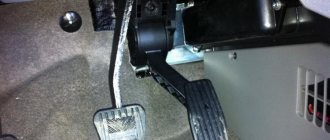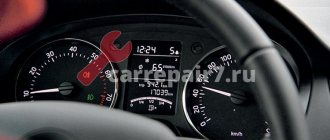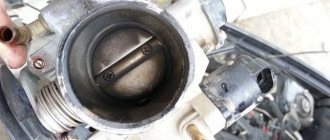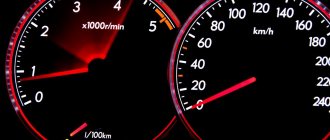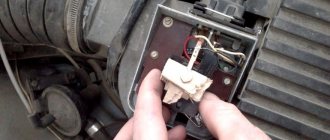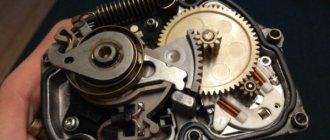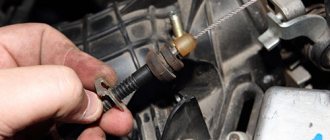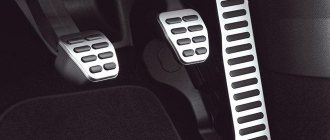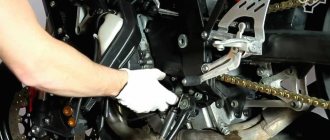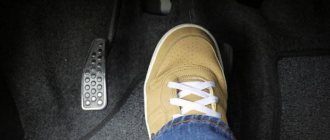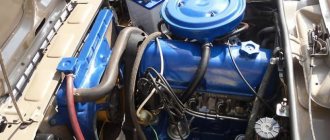The trend of recent years in the automotive industry is the gradual removal of the driver from the process of driving. Designers and marketers have not yet reached the point of losing the connection between arms and legs with turning wheels and braking, but everything is moving towards this. Not a single modern car is supplied to the market without an electronic throttle and an electronic accelerator.
Electronics are reliable things, but sometimes they fail.
The design and principle of operation of the electronic gas pedal
To understand how it works and functions, you need to roughly understand the general circuit of the mechanical analogue. The functions of these systems are similar, but the simplest unit can only be considered a traditional drive.
The gas pedal is a control element for the throttle and its damper. The function of the throttle is to regulate the amount of air. The more air, the higher the engine speed the crankshaft will rotate. The pedal is connected to the throttle drive via a cable drive or levers. All this significantly reduces the effort required to press the gas.
The operating principle of the electronic unit is more complex, but this makes the process of controlling speed easier. The electronic accelerator is used only on engines with an injection power system. Its device is completely electronic. It is based on electronic modules that convert electrical signals.
Principle of operation
The entire electronic throttle control system consists of three main elements: the electronic pedal module, the control unit and the throttle control module.
- The electronic gas pedal is a plastic pedal-lever with two position sensors. The sensors are potentiometers whose movable contact is rigidly connected to the rotary axis of the pedal.
- The electronic control unit (ECU) constantly monitors the position of the pedal using sensors and, based on these and additional signals, sends commands to control the throttle gearbox and fuel injectors.
- The throttle control module receives signals from the ECU and changes the position of the throttle valve. Its position is also monitored by two sensors, the signal from which is sent to the ECU for feedback.
Symptoms of a problem
Among the main signs of problems are:
- Absence of any reaction to the accelerator after starting the vehicle’s internal combustion engine;
- Dips, loss of throttle response while driving;
- Floating idle speed;
- Sharp jumps in speed when you gently press the accelerator;
- Idle speed too high.
The device contains movable electrical contacts, as well as conductive tracks - these elements are subject to wear during operation. In the operation of the engine, you can observe dips when picking up speed, unstable idling.
Related article: 5 of the best car speakers for high-quality sound
If there is a malfunction in the unit, the driver can see this by a warning light on the dashboard. In such a situation, the ECU will switch the engine to standby mode.
In this mode, you can observe a slow increase in speed, even if you press the accelerator sharply. In addition, the vehicle's fuel consumption may increase significantly.
If two sensors in a unit fail at once, the ECU will switch the operation of the internal combustion engine to emergency mode - the driver will not be able to influence the operation of the engine, the speed under any conditions will be slightly higher than the idle speed.
Ignition and injection
During normal operation, the spark plug receives an electrical signal from the distributor or electronic injection system and sends a current pulse to the electrodes in a fraction of a second. Thus, the vapors in the combustion chamber are ignited. However, there are many reasons why a spark plug may stop sparking properly.
There are many methods for detecting and eliminating problems with spark plugs, but it is better to carry out diagnostics from specialists. A novice mechanic can do the following:
- Check the wires going to the spark plugs. Sometimes rough running of the engine is caused by damaged, worn or misconnected spark plug wires.
- Replace the suspect spark plug. Throughout its entire service life, it must retain its original appearance. If the spark plug is damaged, covered with oil or carbon deposits, you should contact a professional to further diagnose the causes of this condition.
Another factor why the spark plug does not generate a spark may be a malfunction of the ignition coil. This important component increases the vehicle voltage to 30,000 volts, which is the main condition for the formation of a spark. Coil defects cause misfires, which manifest themselves as jerking of the car.
Another common problem in the ignition system is contamination of the injector nozzles. This is not a very serious defect, but it also needs to be eliminated. It is advisable to clean the injectors on a regular basis to avoid costly replacements.
Adjustment
The adjustment process may vary on different car models, since different manufacturers use mechanisms of different designs. But the same principle can be applied for configuration. As for a specific model, it is better to find information on it in advance.
To begin the adjustment, the first step is to remove the pedal from the holding bracket. Next, loosen the screws securing the cover. One screw holds the cover in a certain position - it must be completely unscrewed. The cover is turned to the side clockwise until the end, then the screws are tightened again.
This is interesting: How to make a foam generator for a car wash with your own hands
This adjustment will reduce pedal response time. Some car owners note that after such adjustments, the response speed can even be compared with a mechanical pedal. Adjustment allows you to improve engine performance and improve the start of movement from a standstill.
In cases where a pedal with low sensitivity is needed, it is necessary to rotate the cover in the opposite direction - counterclockwise. The machine begins to respond to presses not so quickly.
Sometimes you can come across harmful adjustment tips - drivers advise placing shims under the lever. This is the wrong approach. Sometimes the pads get caught under the contact pads in the potentiometer, and the machine may lose control as a result.
Very hard pedal
The pedal is tight, the stroke is short when pressed... When braking, the car loses directional stability, trying to go to the side. Most often this happens when the caliper cylinders jam in one of the system circuits. If the car does not skid anywhere, and the trouble is expressed only in a sharply increased force when braking, the vacuum brake booster or the vacuum supply hose may be to blame.
Sometimes increased pedal effort is caused by the use of low-quality brake pads, as well as excessive contamination and oiling of both the pads themselves and the surfaces of the discs or drums. But this happens quite rarely.
It is also possible that the brake pads may completely wear out or break. It happens that an ice or salt crust forms on the surface of the disks. It is also possible that the brake pad linings are of poor quality, as well as severe corrosion of the brake disc (often more on the inside).
Causes of the phenomenon
Drop in speed and failure of the gas pedal
There are few reasons for the phenomenon of “failure” when pressing the gas pedal. It often appears after unsuccessful engine chip tuning and is accompanied by an increase in fuel consumption, but there are other problems directly with injection. So, let’s look at the main reasons for the “failure” effect:
- Injectors. The fuel distribution system directly affects engine performance.
Identifying and eliminating ECU errors
Condition of the candles. On the left the mixture is too rich, on the right it is too lean.
These are all the main reasons that can lead to gas pedal failure.
Dips during acceleration
Once the causes are considered, we can consider how to deal with the problem. So, let’s describe step by step what needs to be done when the gas pedal has dips during acceleration:
- The first step is to check the spark plugs. The appearance of carbon deposits or spark plugs that are too clean indicate that the mixture is not adjusted correctly. It is worth adjusting the correct amount of fuel mixture.
- Ignition wires can also cause the vehicle to malfunction.
- A clogged throttle can lead to failures during acceleration.
- The condition of the air filter affects the formation of the mixture, so it is worth changing it on time.
Air filter clogged
Dirty fuel filter
Dirty fuel filter
- ECU errors can also lead to accelerator failures.
- The last reason is clogged injectors. They need to carry out diagnostics, check functionality, and also clean and replace faulty elements.
Thus, the causes of failures during overclocking have been identified and can be eliminated.
Gas leaks at idle
At idle, there are fewer reasons for failures, but they will have to be eliminated, since the car simply will not start normally, or stall after starting the engine. So, let's look at the work plan step by step:
- Checking the spark plugs. If the element fails, it is necessary to replace it.
Attention! It is recommended to change all four spark plugs to ensure smooth engine operation. Before installation, you should adjust the gap using a feeler gauge, which should be 1 mm for 92 gasoline
Checking and adjusting the spark plug gap using a feeler gauge
- We change the fuel filter, it is located under the bottom of the tank, and also carry out diagnostics on the fuel pump. If malfunctions are identified, they should be eliminated.
Clogged filter in the gasoline pump
All these reasons can cause dips to appear at idle (more precisely, when switching from idle to driving mode).
Lubricating the throttle cable on a Priora at home
To work you will need:
- Flat screwdriver;
- Pliers;
- A syringe and a few drops of motor oil or WD-40.
Actually the work itself...
1. First you need to turn off the engine and let it cool.
3. To remove the throttle cable, you need to remove it from the plastic bracket; to do this, pull the cable casing towards you and, pushing the rubber ring up, remove the cable.
4. Now you need to disconnect the cable from the throttle valve drive. To do this, remove the U-shaped metal bracket from the throttle actuator by prying off one edge using a flathead screwdriver.
5. We remove the cable from the hook, overcoming the force of the spring.
6. Now that nothing is in the way, you can begin to lubricate the throttle valve actuator; to do this, you need to slide the transparent cap and generously lubricate the cable with a few drops of engine oil or WD-40 penetrating fluid. In the case of oil, prepare a syringe.
Try to pour oil into the housing, then move the housing to lubricate the cable along its entire length. Repeat the procedure several times until the cable is completely lubricated.
Description of the problem
In general, there was a terrible downpour, puddles on the roads, and general floods in the yards.
Heavy rain could affect the operation of the car's electronic systems
But we had to go, my wife and daughter were in the shopping center, and the queue for the minibus, according to them, was huge. I am inclined to believe that the minibuses simply stalled (we have old, decrepit Gazelles in our city).
What actions to take if a clutch malfunction occurs?
how to adjust the clutch on a Priora if there are not enough threadsImportant for the motorist to know
It is extremely important to listen to your vehicle. Timely detection of a breakdown and its elimination (the sooner the better) will help to avoid more serious consequences. Fixing a clutch malfunction means replacing the entire system or its individual element
Another disadvantage: only experienced and fanatical car owners will be able to cope with this task on their own. Most drivers who do not have their own garage and certain skills are unable to replace the unit and have to go to a service station
Fixing a clutch malfunction means replacing the entire system or its individual element. Another disadvantage: only experienced and fanatical car owners will be able to cope with this task on their own. Most drivers who do not have their own garage and certain skills are unable to replace the unit and have to go to a service station.
Another disadvantage of a unit malfunction is the cost of replacing it or replacing individual elements. If you have a foreign car, be prepared for huge costs.
Have you discovered a clutch malfunction on the road, what to do in such a situation? You need to immediately go to a car service center, because you won’t be able to drive such a car for a long time. But what to do if the service station is far away and there is no one to tow it? A trick like double-depressing the clutch pedal will help you.
When upshifting, you need to depress the pedal, shift to neutral and release the pedal. Then we depress the pedal again, switch to a higher gear and release it again. When downshifting, you need to depress the clutch pedal, go to neutral, release it, add gas, depress it again, downshift and release the pedal again.
If you still decide to repair the clutch system yourself, here are brief instructions for locating the fault: the most important thing is to correctly and very carefully disassemble the unit basket, inspecting all the discs, pay attention to worn parts, determine the condition of the springs and the number of oils The important part is inspecting the release bearing. Most often, many malfunctions are associated with it.
Most often, many malfunctions are associated with it.
Most often, many malfunctions are associated with it.
The important part is inspecting the release bearing. Most often, many malfunctions are associated with it. But it’s best, if a malfunction is detected, to sign up for diagnostics and service by experienced technicians at a car service center in Moscow
Yes, the price will be high, but the quality of the work matches this!
But it is best, if a malfunction is detected, to sign up for diagnostics and service by experienced technicians at a car service center in Moscow. Yes, the price will be high, but the quality of the work matches this!
You can make an appointment for clutch repair or replacement in Moscow by calling the phone numbers below or by leaving a request on our website. Within a short time, the manager will contact you and answer all your questions.
If the article was useful to you, tell your friends about it!
